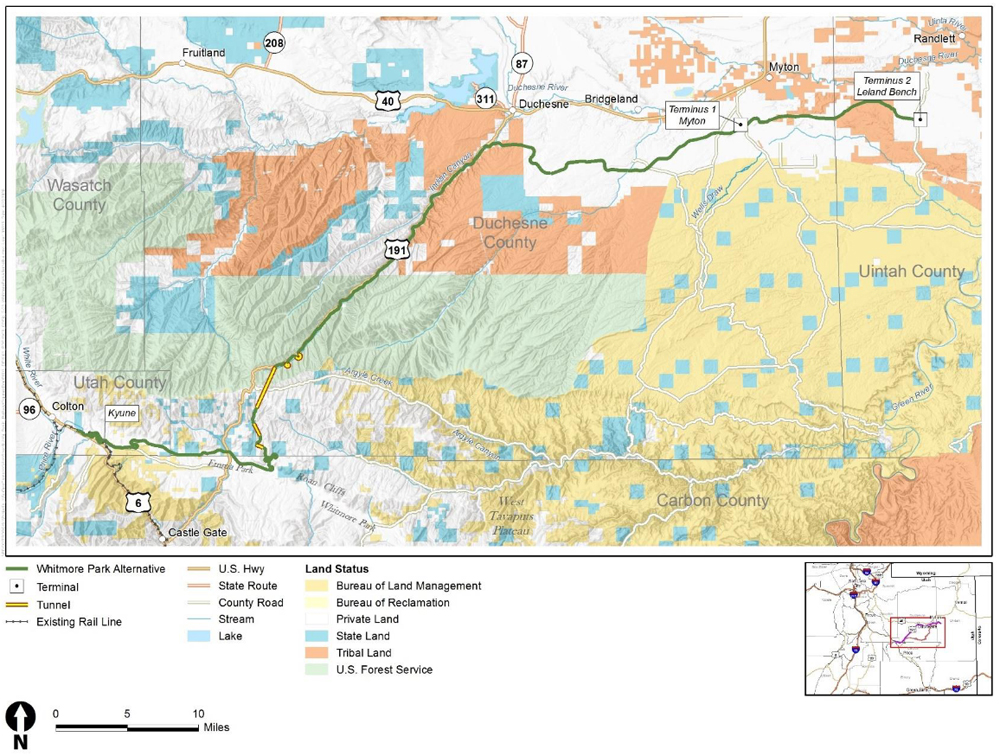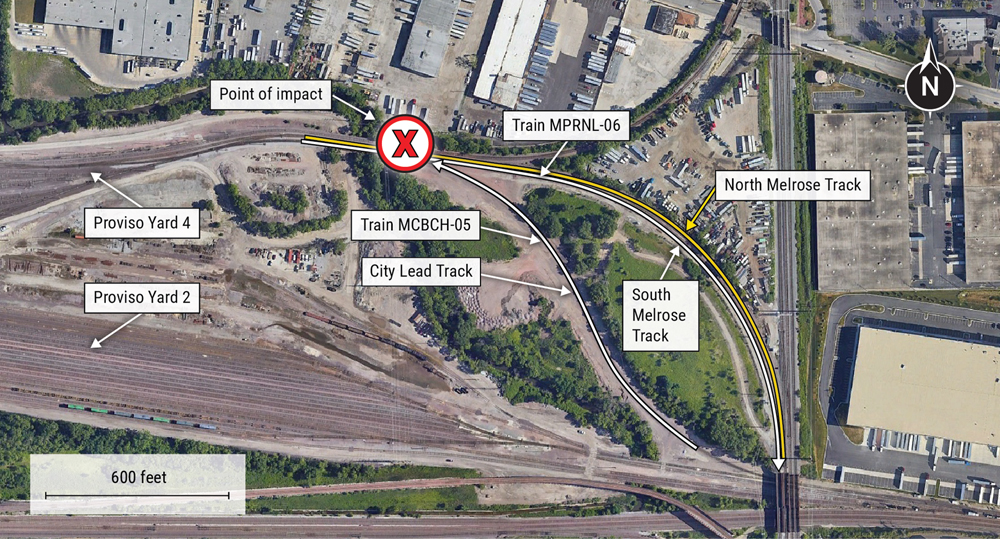
WASHINGTON — A federal court has struck down the Surface Transportation Board’s approval of the Uinta Basin Railway project, calling the decision allowing its construction “arbitrary and caprious.” The court also vacated the Environmental Impact Statement and a related document underlying that decision and sent the matter back to the STB.
In granting the exemption sought by the coalition allowing construction of the 88-mile rail line in eastern Utah, the board had said the project “is likely to produce unavoidable environmental impacts” but that “the transportation merits … outweigh the environmental impacts” [see “STB clears path for Uinta Basin Railway project,” Trains News Wire, Dec. 16, 2021].
 But Friday’s ruling from the U.S. Court of Appeals for the District of Columbia — in a suit brought by Eagle County, Colo., and several environmental groups against the STB and Seven County Infrastructure Coalition, the group seeking to build the railway — said the court found the environmental report from the STB’s Office of Environmental Analysis “failed to demonstrate that the Board took the requisite ‘hard look’ at all the environmental impacts of the Railway.”
But Friday’s ruling from the U.S. Court of Appeals for the District of Columbia — in a suit brought by Eagle County, Colo., and several environmental groups against the STB and Seven County Infrastructure Coalition, the group seeking to build the railway — said the court found the environmental report from the STB’s Office of Environmental Analysis “failed to demonstrate that the Board took the requisite ‘hard look’ at all the environmental impacts of the Railway.”
Opponents of the project hailed the ruling.
Eagle County Attorney Bryan Treu told the Colorado Sun the board “cut corners in their environmental analysis of this project, particularly as it relates to Colorado, and now they have to start over.” Deeda Seed of the Center for Biological Diversity, another of the plantiffs in the case, said in a press release the decision was “an enormous victory for our shared climate, the Colorado River, and the communities that rely on it for clean water, abundant fish, and recreation.”
Meanwhile, the Seven County coalition, in a joint statement with its financing partner, DHIP Group, told the Salt Lake Tribune it was “ready, willing, and capable” of working with the STB “to ensure additional reviews and the project’s next steps proceed without further delay. We look forward to bringing this railway to the basin.”
STB spokesman Michael Booth told the Associated Press the agency does not comment on pending litigation.
The decision by the three-judge panel was critical of the failure to consider impacts of the project beyond its immediate area, saying it agreed with the plaintifs’ contention that the final environmental report “ignored certain upstream and downstream impacts.” Specifically, the court faulted the board’s failure to consider the larger environmental impacts of the oil drilling in the Uinta basin, and from the later refining of that oil.
The board argued in part that such impacts “are not reasonably foreseeable,” and in part that it was not required to consider environmental impacts of refining because it “cannot regulate or mitigate” such impacts.
But Judge Robert L. Wilkins, writing for the panel that also included Judges Patricia Millett and Cornelia Pillard, rejected both arguments.
On the first point, he wrote, “The Board provides no reason why it could not quantify the environmental impacts of the wells it reasonably expects in this already identified region. Further, the Board’s cursory assertion that it could confine the upstream impacts of oil
development on vegetation and wildlife to areas where oil development and railroad construction would overlap lacks any reasoned explanation and is unsupported in the record.”
On the second, he wrote, “the board “cannot avoid its responsibility under [the National Environmental Policy Act] to identify and describe the environmental effects of increased oil drilling and refining on the grounds that it lacks authority to prevent, control, or mitigate those developments. … (G)iven that the Board has the authority to deny an exemption to a railway project on the ground that that railway’s anticipated environmental and other costs outweigh its expected benefits, the Board’s argument that it need not consider effects it cannot prevent is simply inapplicable.”
The court also found the environmental report failed to provide the required “hard look” because it did not consider the increased risk of a rail accident or wildfire downline because of increased rail traffic, or the impact on water resources resulting from such events.
That concern over downstream impacts, particularly the risks resulting from an accident involving a train transporting oil from the Uinta Basin project along UP’s mainline through the Colorado Rockies, was a primary point of contention for Eagle County.
The lack of scope played a similar role in the court vacating the Biological Opinion on potential impacts on endangered species and critical habitats was a part of the environmental report.
In that regard, Wilkins wrote, “The Board’s reasoning for narrowly defining the action area not to include waterways downline near the Union Pacific Line is unreasoned and fails to demonstrate a ‘rational connection between the facts found and the choices made.”
The 627-page environmental report, accompanied by almost 2,300 pages of appendices, was issued in August 2021.
— Updated Aug. 19 at 8:45 p.m. with comment from Seven County Infrastructure Coalition.














By extension, and hypothetically, should the Moffat Road, Moffat Tunnel, Dotsero Cutoff and the former D&RGW the rest of the way westward to the Utah state line never have been built? Of course, we can’t go backwards in time — only forward. So, should the existing railroad route therefore be shut down and mothballed in light of this decision that seems to have usurped the STB and national transportation policy at least temporarily? Of course, shutting down the existing rail line altogether would include the existing Amtrak service that would be re-routed via Wyoming or suspended. Perhaps the tourism-oriented businesses along that route would take it in stride?
The permitting process needs major reform. Parties should not be allowed to sue who have no immediate connection to the project. i.e. extreme environmental groups just because they don’t like oil production.
Amazing. So now the STB is to take into consideration oil drilling and refining. Wonder what happens if they start drilling and thousands of trucks carrying oil end up on the highway, possibly to a distant transload area. Let’s not forget any potential dust, mud, weeds and the list goes on.
That has already happened in Utah. Route 40 from the Uintah Basin ti the Wasatch Front is a mess with 30,000 gallons tankers running at high speed with weights that the road was not designed for. That was one of the biggest reason UDOT and other state agencies supported this project. The oil will still go to market by rail, just not through the South Slope canons of Colorado. Funny, the tankers can continue to drive that direction as well asother hazardous chemicals but they don’t count to these environmentalist…. no matter how many of those crash.
Maybe the Uintah Railway should declare that they will not go through Colorado but will ship the oil via Provo-Ogden,Utah and eastward on the UP’s Overland Route. And they would still be able to ship through Colorado by dropping down through Denver from Cheyenne, WY and down the Joint Line through Pueblo, CO if necessary. Its the long way around but it is the legal free way, Oil already travels this way from Northern Colorado and Wyoming to southeast markets in Texas and Louisiana as well as east from Cheyenne to points in Oklahoma, and the Northeast. What these folks in Eagle County have done is only delay this project. It is going to happen whether they like it or not… It will just cost more and take a little more time…
I supposed you could say the project is going to kill people because the oil transported may be refined into gasoline which may be used in a car that may have a fatal crash 10 years from now.
No wonder we can’t get anything done in this country anymore.
Let the stepchildren of illegtimate parentage freeze and starve in the silent darkness.
Ahem, if I were a lawyer…..
Perhaps I would file a suit against Eagle County, Colorado. Their zoning laws allow yet more housing development in an ecologically sensitive area and demand that Eagle County run a complete review and audit of their wastewater treatment facilities. That their ability to see and ignore the downstream impacts of their wastewater products has been both arbitrary and capricious.
It is the responsibility of Eagle County to make sure that they are responsible and accountable to the type of wastewater and waste products they allow into the local ecosystem. By allowing yet more development of commercial and residential land without the adequate capabilities to remediate with no damage to the Colorado River Basin is illegal and is dis-respective of the spirit of environmental law.
The suit would be filed against the Colorado EPA, the US-EPA and Eagle County, Colorado.
You see I am not an attorney, therefore this statement is merely an example of what is possible when someone with a log in their eye is attempting to call out the speck in someone else’s.